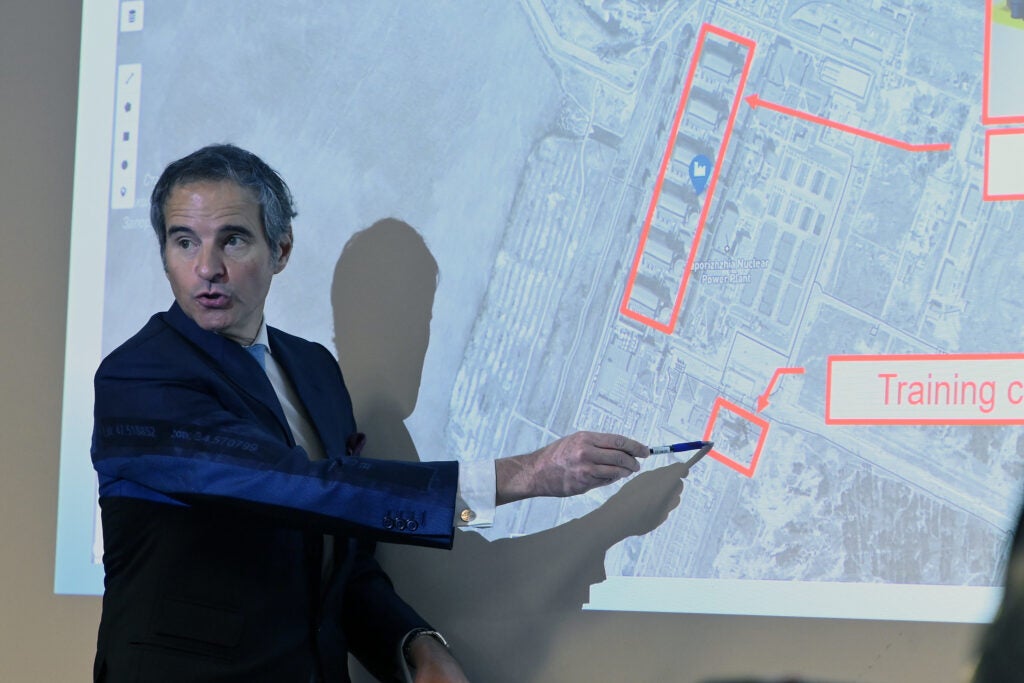
A Russian military commander has directly threatened to the integrity of the Zaporizhzhia nuclear plan if forced to retreat.
Ukraine’s nuclear state enterprise, Energoatom, has published a now-deleted social media post attributed to Major General Valeriy Vasiliev, commander of the garrison occupying the Zaporizhzhia Nuclear Power Plant. In the post, distributed by encrypted communications app Telegram, Vasiliev states that the plant “will be Russian or no-one’s.”
The statement emphasises the number of mines planted in the area. It continues: “We do not hide this from the enemy [Ukrainian forces]. We warned them. […] We are ready for the consequences.”
Ukrainian news sources reporting the statement say they have not been able to confirm its origins. Representatives of the Russian Government or military have not yet commented on the statement. However, Telegram channels controlled by the Russian state have denied its authenticity. It remains unclear whether this represents official strategy, or a rhetorical threat from the commander in the field.
The website of Energoatom also claims that Russian forces are using the turbine hall of the plant to store their military equipment. The Ukrainian company states that the Russian military has stored “at least 14 units of heavy military equipment with ammunition, weapons and explosives” in Zaporizhzhia’s Unit 1.
Nevertheless, Russian invading forces have indirectly but knowingly threatened the safety of operations of the nuclear power station. The plant has laid near the front lines for most of the war, with Russian forces currently occupying the area.
How well do you really know your competitors?
Access the most comprehensive Company Profiles on the market, powered by GlobalData. Save hours of research. Gain competitive edge.

Thank you!
Your download email will arrive shortly
Not ready to buy yet? Download a free sample
We are confident about the unique quality of our Company Profiles. However, we want you to make the most beneficial decision for your business, so we offer a free sample that you can download by submitting the below form
By GlobalDataIn March, artillery strikes by Russian forces caused a fire at the plant, leading to international alarm. It later emerged that the damage remained contained to the plant’s administrative and training blocks. However, the use of explosive so close to the reactors, as well as the militarisation of the surrounding area, caused condemnation from international governments, as well as nuclear safety authorities.
IAEA director concerned by “very real risk of nuclear disaster” at Zaporizhzhia
The International Atomic Energy Agency (IAEA) has repeatedly warned of how the ongoing war has eroded safety at the plant. Recently, the agency described the plant as “out of control”.
On Saturday, IAEA director general Mariano Grossi issued a statement expressing “extreme concern” at the “very real risk of nuclear disaster”.
He wrote: “The IAEA has received information about this serious situation – the latest in a long line of increasingly alarming reports from all sides. According to Ukraine, there has been no damage to the reactors themselves and no radiological release. However, there is damage elsewhere on the site.
“Military action jeopardising the safety and security of the Zaporizhzhia nuclear power plant is completely unacceptable and must be avoided at all costs. Any military firepower directed at or from the facility would amount to playing with fire, with potentially catastrophic consequences.
“I strongly and urgently appeal to all parties to exercise the utmost restraint in the vicinity of this important nuclear facility, with its six reactors.”

Statements from the IAEA have repeatedly emphasised the importance of the “seven pillars of nuclear safety”. These include: physical integrity of nuclear facilities, functionality of safety equipment, ability of operating staff to act “free of undue pressure”, off-site power supply from the grid, uninterrupted supply and transport chains, effective and widespread radiation monitoring with readiness in case of emergency, and reliable communications.
In his recent statement, Grossi wrote: “Ominously, however, almost all have been compromised at the Zaporizhzya nuclear power plant over the past several months, and yet again, in the last 24 hours, several pillars have been violated.”
If damaged, fallout from the nuclear plant would likely drift toward Russia. After the meltdown and explosion of the Chernobyl Nuclear Plant in 1986, radioactive particles drifted across the continent toward Moscow. At the time, USSR forces countered this with a bombing campaign in modern Belarus, causing contaminants to fall there instead.
Earlier this year, the IAEA highlighted the danger of Russian activity at the Chernobyl nuclear plant. Over the course 14 days, staff were prevented from leaving the site with no relief from work. Russian forces also disconnected the plant from the power grid, threatening the power supply to the containment structure. During this time, the New Safe Containment building was forced use backup generators to maintain site safety.



